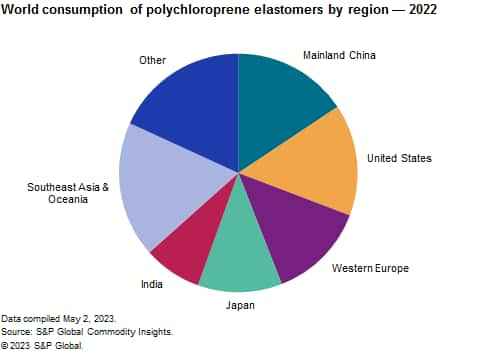Published June 2023
Polychloroprene elastomers (CR, polychloroprene rubber, or chloroprene rubber) was the first commercially successful synthetic elastomer, and it was synthesized accidentally in 1930 in a DuPont laboratory. First named DuPrene® and later renamed Neoprene®, the elastomer went on the market in 1931. Polychloroprene is produced in a wide variety of grades in both solid/dry and latex/wet forms. In general, solid grades of CR are normally used in industrial and automotive rubber goods such as hoses and belts. Latex grades of CR are used in adhesives and dipped goods (for example, polychloroprene surgical gloves and other items). At present, polychloroprene rubber is produced commercially in the United States, Germany, Japan and mainland China.
Polychloroprene is known primarily for its resistance to weathering, good mechanical strength, excellent combustion behavior, aging and heat resistance, moderate oil and fuel resistance, tear and wear resistance, resistance to water and a large number of chemicals over a long period of time, good adhesion to many substrates, low gas permeability, resistance to soil bacteria and fungi, and good electrical properties for a large number of applications. However, CR tends to be higher priced than other elastomers, has only fair dielectric properties, a mediocre resistance to low temperatures, and loses resilience above 120°C. CR compounds are suitable for use up to 80-90°C in continuous service.
The following chart shows world consumption of polychloroprene elastomers in 2022:

The four largest consumers of polychloroprene elastomers are mainland China, the United States, Japan and India. These four markets accounted for half of total global CR consumption in 2022.
Overall, worldwide consumption of polychloroprene elastomers is expected to increase in the next five years, led by consumption growth in mainland China. Mainland China will have the fastest growth in terms of polychloroprene elastomers consumption to support its growing automotive, adhesives, construction, industrial rubber goods, and other uses applications.
For more detailed information, see the table of contents, shown below.
S&P Global’s Chemical Economics Handbook – Polychloroprene (Neoprene) Elastomers is the comprehensive and trusted guide for anyone seeking information on this industry. This latest report details global and regional information, including

Key benefits
S&P Global’s Chemical Economics Handbook – Polychloroprene (Neoprene) Elastomers has been compiled using primary interviews with key suppliers and organizations, and leading representatives from the industry in combination with S&P Global’s unparalleled access to upstream and downstream market intelligence and expert insights into industry dynamics, trade and economics.
This report can help you
- Identify trends and driving forces influencing chemical markets
- Forecast and plan for future demand
- Understand the impact of competing materials
- Identify and evaluate potential customers and competitors
- Evaluate producers
- Track changing prices and trade movements
- Analyze the impact of feedstocks, regulations, and other factors on chemical profitability


















